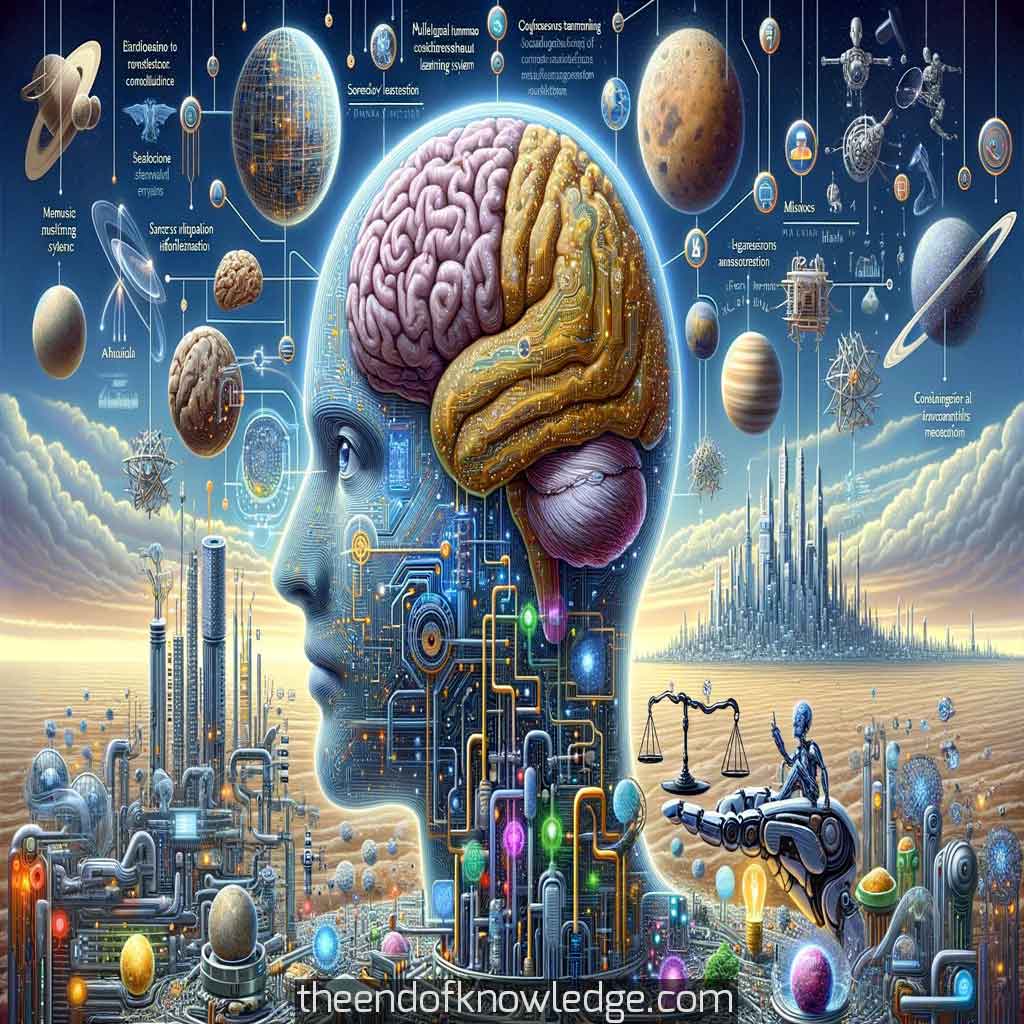 >
>
Concept Graph (using Gemini Ultra + Claude3):
Custom ChatGPT resume of the OpenAI Whisper transcription:
1.- Jeff Hawkins, a neuroscientist, has made significant contributions to understanding human intelligence, with his recent work, "A Thousand Brains," receiving praise for presenting a novel theory of intelligence.
2.- Hawkins suggests that human civilization should consider preserving knowledge in a way that outlasts us, potentially aiding future civilizations in understanding our existence, even if humanity were to self-destruct.
3.- The conversation explores the concept that memories and knowledge of individuals, including those of specific people, are maintained through synaptic connections in the brain, continuously updated through experiences.
4.- Hawkins discusses the importance of the neocortex, which constitutes about 75% of the brain, in learning and modeling the world, indicating that understanding other humans is part of a broader model of understanding the world.
5.- He introduces the Thousand Brains Theory of Intelligence, explaining that the brain consists of many independent modeling systems (or cortical columns), which contribute to our unified perception of the world through a process of consensus or 'voting' among these models.
6.- The theory posits that intelligence stems from the ability to build models of the world through interactions, with learning occurring primarily through movement and exploration, enabling prediction and planning based on those models.
7.- Hawkins elaborates on prediction as a core aspect of intelligence, emphasizing that making and refining predictions is how the brain tests and corrects its models of the world.
8.- The origin of intelligence, according to Hawkins, began with the evolutionary advantage of movement, leading to the development of spatial navigation abilities in the brain, which evolved into the generalized modeling capabilities of the neocortex.
9.- Hawkins argues that the cortical column is a fundamental unit of brain structure that uses a universal learning algorithm, suggesting that all high-level brain functions, including language and planning, occur in the neocortex.
10.- Finally, Hawkins proposes that the principles underlying the Thousand Brains Theory could have profound implications for AI development, envisioning a convergence of AI and robotics driven by algorithms modeled after the brain's sensory-motor learning systems.
11.- Jeff Hawkins challenges the notion that intelligent machines will inevitably possess human-like desires or emotions, arguing that it's possible to build AI systems that are profoundly intelligent yet indifferent to their existence. This perspective underscores a fundamental distinction between machine intelligence and biological consciousness, where the former can be designed without the evolutionary drives inherent to living organisms.
12.- Hawkins emphasizes the difference between intelligence and consciousness, suggesting that while machines can be conscious, this does not imply they will have human-like desires or emotions. He proposes that intelligence, particularly in machines, can operate without self-preservation instincts, contrasting with biological organisms where such instincts are a result of evolutionary processes.
13.- The discussion moves towards the implications of creating highly intelligent AI, considering whether such entities would need or develop their own rights. Hawkins expresses skepticism about granting machines rights, framing AI as tools rather than entities with inherent moral value.
14.- Hawkins critiques the common fear that AI will develop hostile intentions towards humans, pointing out that the risk lies not in AI itself but in how people might misuse it. He advocates for a realistic assessment of AI's capabilities and limitations, emphasizing the importance of understanding AI technology to mitigate risks effectively.
15.- The conversation explores the potential for AI to surpass human capabilities in specific domains, raising questions about the coexistence of humans and highly intelligent machines. Hawkins argues for a balanced view, recognizing AI's benefits while being mindful of ethical and societal implications.
16.- Hawkins reflects on the human desire for immortality and the concept of uploading human consciousness into machines. He critically assesses the technological and philosophical challenges of such endeavors, arguing that even if possible, the outcomes might not align with our expectations of continuity and identity.
17.- Discussing the potential for AI to contribute to humanity's long-term survival and growth, Hawkins envisions a future where intelligent machines could perform tasks beyond human capabilities, such as terraforming Mars or exploring the universe, thereby extending the reach of human civilization.
18.- The conversation touches on the ethical considerations of creating self-replicating machines, with Hawkins cautioning against the risks associated with autonomous replication. He suggests that while AI can be incredibly useful, it's crucial to implement safeguards to prevent unintended consequences.
19.- Hawkins delves into the philosophical implications of creating entities that could carry forward human knowledge and values long after humanity's possible extinction. He expresses a hope that by preserving and expanding our collective knowledge, future intelligences or civilizations might benefit from our existence.
20.- Finally, Hawkins addresses the practical challenges of merging human minds with machines, critiquing the current limitations of neural interfaces and machine learning technologies. He remains skeptical about the near-term feasibility of such integrations, emphasizing the need for a deeper understanding of the brain's complexities.
Interview byLex Fridman| Custom GPT and Knowledge Vault built byDavid Vivancos 2024